Ronald Anthony Parise
| Ronald Anthony Parise, Ph.D. | |
|---|---|
 | |
| Astronaut NASA | |
| Státní příslušnost | |
| Datum narození | 24. května 1951 |
| Místo narození | Warren, Ohio |
| Datum úmrtí | 9. května 2008 (ve věku 56 let) |
| Místo úmrtí | Silver Spring, Maryland |
| Předchozí zaměstnání | astronom |
| Čas ve vesmíru | 25 dní, 14 hodin a 13 minut |
| Kosmonaut od | 1984 |
| Mise | STS-35, STS-67 |
| Znaky misí | |
| Kosmonaut do | 1995 |
| Některá data mohou pocházet z datové položky. | |
Ronald Anthony Parise (24. května 1951 Warren, Ohio – 9. května 2008 Silver Spring, Maryland) byl americký astronom a kosmonaut. Ve vesmíru byl dvakrát.
Život
Studium a zaměstnání
Absolvoval střední školu Western Reserve High School a poté absolvoval vysokoškolská studia na univerzitě Youngstown State University a University of Florida. Zakončil je v roce 1979, získal zde titul Ph.D. v oboru astronomie. Pracoval pak u různých společností.
V roce 1984 byl přijat do týmu NASA, po výcviku byl zařazen do oddílu astronautů. V tomto oddílu NASA zůstal do března 1995. U NASA zůstal pracovat jako astronom až do roku 2000.
Používal přezdívku Ron. Oženil se s Cecilií, rozenou Sokolovou a měli spolu dvě děti, Nicholase a Katherine. Zemřel na nádor mozku v květnu 2008 v Silver Spring.[zdroj?]
Lety do vesmíru
Na oběžnou dráhu se v raketoplánech dostal dvakrát s funkcí specialisty pro užitečná zařízení a strávil ve vesmíru 25 dní, 14 hodin a 13 minut. Byl 237. člověkem ve vesmíru.
- STS-35 Columbia (2. prosince 1990 – 10. prosince 1990)
- STS-67 Endeavour (2. března 1995 – 18. března 1995)
Odkazy
Externí odkazy
 Obrázky, zvuky či videa k tématu Ronald Anthony Parise na Wikimedia Commons
Obrázky, zvuky či videa k tématu Ronald Anthony Parise na Wikimedia Commons - Na webu Space
- Na webu MEK-Kosmo
Média použitá na této stránce
portrait astronaut Ronald Parise
STS-35 Mission Insignia
STS-67 Mission Insignia



